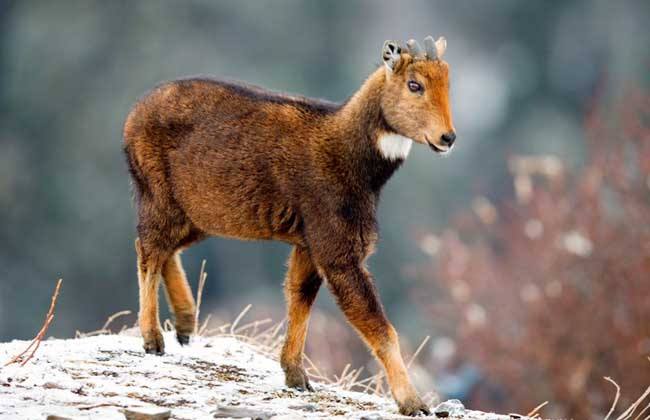Capracornis swinhoei
IUCN
LCBasic Information
Scientific classification
- name:Capracornis swinhoei
- Scientific Name:Capracornis swinhoei,Taiwan serow,Formosan goat, Formosan wild goat
- Outline:Ungulata
- Family:Artiodactyla Bovidae Caprinae Serow
Vital signs
- length:80-114cm
- Weight:17-25kg
- lifetime:About 15 years
Feature
It is a specialty of Taiwan Island, China
Distribution and Habitat
The Formosan Serow is only found in Taiwan Province, China. It is found from low altitudes of 200 meters to high altitudes near Yushan South Peak, Nanhu Valley, and Xueshan Valley.
It lives in rugged forests and rocky slopes between 1,000 and 3,000 meters above sea level along the main mountain ranges in Taiwan, China.
Appearance
The head and body are 80 to 114 cm long, the shoulder height is 50 to 60 cm, the tail length is 70 to 120 cm, and the weight is 17 to 25 kg.
The body color is mainly black and gray, with a black stripe in the middle of the back and neck, the lower jaw is light yellow, with a yellow-brown throat spot, the color of the ventral side is lighter, and the color of the limbs is darker and black. The body hair is rough but dense. Both males and females have horns, which grow on the front of the head. The horns are short and pointed and extend directly backwards. The snout is exposed, the infraorbital glands are obvious, and the ears are long and narrow. The limbs are strong and the tail is short.
Details
Taiwan serow is called Taiwan serow in English, and has no subspecies.

The Taiwan serow is smaller in size and more similar to the goral (Naemorhedus goral) than the mainland's serow (Capricornis sumatraensis), with brown hair, shorter mane than the mainland serow, but more erect, with a light cream spot extending from the chin to the throat, and smaller and thinner horns than the mainland serow.
The Taiwan serow is good at running and jumping, often alone, active at dawn and dusk, and its food includes grass seeds and young leaves of plants. It eats grass, leaves, twigs and some fruits. It usually lives alone, using rocks as cover.
The Taiwan serow especially likes to stand on the top of a cliff with a good view and look around. It is good at running and jumping, very flexible, and can jump up to more than 60 centimeters high, running at a speed of 80 kilometers per hour. It can use its short and thick hind legs to push hard on the gravel cliff slope, so that its front and back feet can leave the ground at the same time, leap into the air, and then land lightly and steadily on the ground with its front hooves. This is because it not only has good eyesight and sense of balance, but also has secondary hooves that are good at walking on steep cliffs. When climbing, it can use the secondary hoof to hold the ground tightly, and the hard main hoof supports the weight. The soft and elastic cuticle of the hoof can increase the adhesion, so it will never fall from the cliff into the abyss due to slipping. It has a relatively strong temperament and often fights with the opponent after being attacked. They are also good at climbing trees and have territoriality. They will use the glands secreted by the infraorbital glands in front of their eyes to smear on branches or protruding stones as a mark.
Taiwan serows mate in September and October. The estrus cycle is about 20 days, and each estrus lasts for 2 to 4 days. At this time, the male loses appetite, calls, urinates frequently, chases the female, and often touches the female's hind legs with his front feet. When reaching climax, the female will actively spread her hind legs and squat slightly, while the male will raise his front limbs and jump up. The mating time is 20 to 40 seconds, with 1 to 2 impulsive movements. The gestation period of females is 7 to 8 months, and they give birth in May to June of the following year, with one cub per litter. The lactation period is 2 to 3 months, and they reach sexual maturity at 2 to 3 years old.
Deforestation, habitat destruction and hunting by hunters are the main reasons for the endangerment of the Taiwan serow.
Listed in the "Red List of Chinese Species" - Endangered (EN).
Listed in the "List of National Key Protected Wildlife in China" - Level I.
Listed as Class II protected animals in the Convention on International Trade in Endangered Species of Wild Fauna and Flora (CITES).
Protect wild animals and stop eating game.
Maintaining ecological balance is everyone's responsibility!








